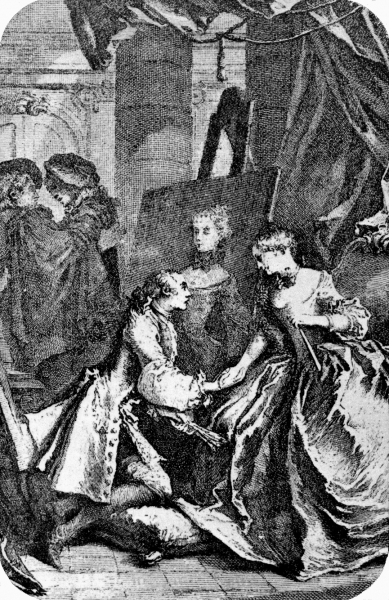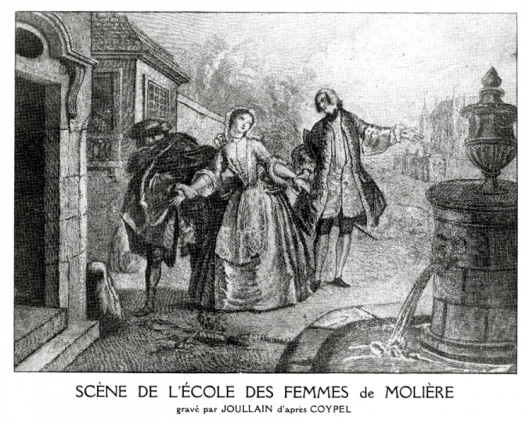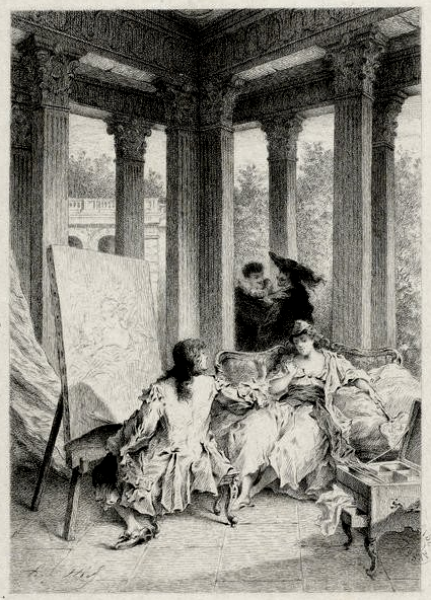Tags
A complete play, Comédie-Ballet, Galanterie & Jealousy, Jean-Baptiste Lully, Le Ballet des Muses, Micheline Bourbeau-Walker, Molière, One-act Play, Sicilien ou l'Amour peintre, The Sicilian; or Loves makes the Painter

Le Sicilien (théâtre-documentation)
Although Le Sicilien ou l’amour peintre forms part of Isaac de Benserade’s Ballet des Muses, and is a comédie-ballet, written by Molière and composed by Jean-Baptiste Lully, it differs from the third entrée: the incomplete Mélicerte and Comic Pastoral. Mélicerte and the Comic Pastoral were pièces de circonstance or plays written for a momentary event. The mourning period that followed the death of Anne d’Autriche, Louis XIV’s mother, was drawing to a close and would give way to festivities that were to take place at Saint-Germain-en-Laye. In other words, these were pièces de circonstance, momentary plays. Molière never wrote the third act of Mélicerte FR and removed the Comédie pastorale‘s FR theatrical scenes. Le Sicilien ou l’Amour peintre was a late entry, the fourteenth. It was first performed on 13 or 14 February at Saint-Germain-en-Laye. It was not shown at the Théâtre du Palais-Royal until 10 June 1667, due to the severe illness Molière’s suffered after the festivities at Saint-Germain-en-Laye.
Moreover, in Le Sicilien, gone are shepherds and shepherdesses. These inhabited the literature of an earlier seventeenth century. The second half of the seventeenth century is often referred to as le Grand Siècle (1661-1715). Louis XIV’s reign began in 1661. The quest for a Golden Age is a permanent feature of literature, and would characterize eighteenth-century fêtes galantes. These would be oniriques, or dream-like. As for Le Sicilien ou l’Amour peintre, its main subject matter would be galanterie and the galant homme. Adraste, disguised as an artist and a Frenchman, is a galant homme. Juxtaposed to Adraste is Dom Pèdre, whose jealous nature keeps him from learning the spellbinding words of galanterie. He loves Isidore, a freed Greek slave, but he so fears losing her that he doesn’t use the words that could endear him to her. We remember l’École des femmes, The School for Wives‘ Arnolphe.
In fact, one could sum up Le Sicilen ou l’Amour peintre by quoting The School for Wives (L’École des femmes). Arnolphe is too jealous to make himself loved. He admonishes Agnès, innocence personified, but Horace knows the appropriate “deux mots,” couple of words, that make him attractive.
Tenez, tous vos discours ne me touchent point l’âme.
Horace avec deux mots en ferait plus que vous.
Agnès à Arnolphe (V. iv, p. 73)
[All you say does not touch my heart.
Horace could do more with a couple of words.]
Agnès to Arnolphe (V. 4. p. 157)


Le Sicilien attribué à Edmond Hédouin (théâtre-documentation)
Le Sicilien ou l’Amour peintre (The Sicilian; or, Love Makes the Painter)
Le Sicilien ou l’Amour peintre is a one-act pastoral and comédie-ballet. The Ballet des Muses consisted of ballets mainly. Voltaire loved it. He wrote: « C’est la seule petite pièce en un acte où il y ait de la grâce. »[1] ‟It is the only little play in one act that has grace.” Molière had graced his one-act Sicilien and, although it was performed as the last ballet at Saint-Germain, it was also performed in Paris. It fared better at Saint-Germain than in Paris, which does not make it a lesser play. However, finding roots is difficult. One may grope, but Molière’s earlier plays are his main source.
Our dramatis personæ are
DON PEDRO, a Sicilian gentleman
ADRASTE, a French gentleman, in love with Isidore
ISIDORE, a Greek girl, Don Pedro’s slave.
A SENATOR. HALT, a Turk, Adraste’s slave.
ZAIDE, a young slave girl.*
Two SERVANTS. MUSICIANS. A SLAVE, singing. SLAVES, dancing. MOORS OF BOTH SEXES, dancing.
*Zaïde is CLIMÈNE, Adraste’s sister.
Adraste would like to speak to Isidore.
In scene five, he complains that Don Pedre is keeping Isidore out of sight. He has seen her and believes they are in love, but he tells Hali that it seems impossible to speak to Isidore. Lovers need to speak to one another.
Quoi! tous nos soins seront, donc, inutiles? et, toujours, ce fâcheux jaloux se moquera de nos desseins?
Adraste à Hali (Sc. v, p. 6)
[What ! Shall all our trouble be for nothing ? Shall this tiresome, jealous fellow always laugh at our attempts?]
Adraste to Hali (Sc. v, p. 65)
Non, le courroux du point d’honneur me prend; il ne sera pas dit qu’on triomphe de mon adresse; ma qualité de fourbe s’indigne de tous ces obstacles; et je prétends faire éclater les talents que j’ai eus du Ciel.
Hali à Adraste (Sc. v, p. 6)
[No. I get angry, and my honour is at stake; it shall not be said that anyone has outwitted me. My reputation as a rogue disdains all these obstacles ; and I am determined to show the talents that Heaven has given me.]
Hali to Adraste (Sc. 5, p. 66)
A stratagem is planned. Pedro will be fooled into thinking that Adraste is Damon, an artist who is supposed to paint a portrait of Isidore. Don Pedro introduces the artist:
Voici un gentilhomme que Damon nous envoie, qui se veut bien donner la peine de vous peindre.
Dom Pèdre à Isidore (Sc. xi, p. 13)
[This is a gentleman whom Damon sends us, and who will be kind enough to undertake your portrait.]
Don Pedro to Isidore (Sc.12, p. 72)
When he meets Isidore, the artist embraces her, so Don Pedro is miffed. Isidore, however, “accepts this honour:”
Holà, Seigneur Français, cette façon de saluer n’est point d’usage en ce pays. (Don Pedro)
[Hullo! Sir Frenchman, this way of saluting is not the fashion in this country.]
C’est la manière de France. (Adraste)
[It is the fashion of France.]
La manière de France est bonne pour vos femmes; mais pour les nôtres, elle est, un peu, trop familière. (Don Pedro)
[The fashion of France may suit your ladies; but for ours, it is somewhat too familiar.]
Je reçois cet honneur avec beaucoup de joie; l’aventure me surprend fort; et, pour dire le vrai, je ne m’attendais pas d’avoir un peintre si illustre. (Isidore)
[I accept this honour with much pleasure. The adventure surprises me immensely; and, to tell the truth I did not expect to have such an illustrious painter.]
(Sc. xi, p. 13/Sc.12, p. 72)
Despite the presence of Dom Pèdre, Adraste courts Isidore whom, until then, he has only seen. Isidore doesn’t know whether he is truthful, but Adraste is convincing:
Oui, charmante Isidore, mes regards vous le disent depuis plus de deux mois, et vous les avez entendus: je vous aime plus que tout ce que l’on peut aimer, et je n’ai point d’autre pensée, d’autre but, d’autre passion, que d’être à vous toute ma vie.
Adraste à Isidore (Sc. xii, p. 16)
[Yes, charming Isidore, my looks have told you as much for the last two months, and you have understood them. I love you more than aught else, and have no other thought, no other aim, no other passion, than to be yours all my life.]
Adraste to Isidore (Sc. 8, p. 75)
Je ne sais si vous dites vrai, mais vous persuadez.
Isidore à Adraste (Sc. xii, p. 16)
[I do not know whether you speak the truth ; but you make me believe you.]
Isidore to Adraste (Sc. 8, p.75)
[What are you waiting for?]
Adraste to Isidore (Sc. 14, p. 76)
[To make up my mind.]
Isidore to Adraste (Sc. 14, p. 76)
[Ah ! when people love with all their hearts, they
make up their minds quickly.]
Adraste to Isidore (Sc. 14, p. 76)
[Very well then ! yes, I consent to it.]
Isidore to Adraste (Sc. 14, p. 76)
In Scene XIV, Climène, Adraste’s sister, bursts onto the scene, asking to be protected from a jealous husband. Don Pedro is surprised. He believes Frenchmen are not jealous. But the French, it appears, excel in every way.
Les Français excellent toujours dans toutes les choses qu’ils font[.]
So, Don Pedro lets Climène/Zaïde enter wearing a veil. He lest her join the artist and Isidore, not knowing that he will be tricked. Climène gives Isidore her veil, which is how Adraste and Isidore leave unnoticed.
Ah! Seigneur cavalier, sauvez-moi, s’il vous plaît, des mains d’un mari furieux dont je suis poursuivie. Sa jalousie est incroyable, et passe dans ses mouvements tout ce qu’on peut imaginer. Il va jusques à vouloir que je sois, toujours, voilée; et pour m’avoir trouvée le visage un peu découvert, il a mis l’épée à la main, et m’a réduite à me jeter chez vous, pour vous demander votre appui contre son injustice. Mais je le vois paraître. De grâce, Seigneur cavalier, sauvez-moi de sa fureur.
Climène/Zaïde à Dom Pèdre (Sc. xiv, p. 18)
[Ah, Sir, save me, I beseech you, from the hands of an enraged husband who is close upon my heels. His jealousy is incredible, and surpasses in its violence every-thing imaginable. He carries it so far as to wish me to be always veiled ; and for having found me with my face a little uncovered he has drawn his sword, and he has compelled me to throw myself upon you, and to ask for your protection against his injustice. But I see him coming ; for heaven’s sake, honoured Sir, save me from his fury.]
Zaïde/Climène to Don Pedro (Sc. 15, p. 77)
Entrez là-dedans, avec elle, et n’appréhendez rien.
Dom Pèdre à Climène/Zaïde (Sc. xiv, p. 18)
[Go in there with her, and fear nothing.]
Don Pedro to Zaïde/Climène (Sc. 15, p. 77)

Le Sicilien par Adolphe Lalauze (théâtre-documentation)
Comments
“Salons” nurtured both l’honnête homme and le galant homme. Le galant homme is not un homme galant, a womanizer. Le galant homme is refined and knows how to please a woman, as does l’honnête homme. Charles Sorel is the author of Les Lois de la galanterie (1644), and Nicolas Faret wrote L’Honnête homme ou l’Art de plaire à la cour (1630). Molière himself sought to please … an audience.
In short, in Le Sicilien, Molière remembers jealous and possessive men. These men court women speaking the language of accountants. Moreover, they often resort to the law. They have rights. Don Pedro speaks to the Senator who can only think of a mascarade he has written. It’s a dialogue de sourds. Molière remembers Arnolphe. He also remembers Horace who tells each one of his plans to Arnolphe, but defeats Arnolphe.
According to Marcel Gutwirth, Molière main characters are le Jaloux, jealous men, l’Imposteur (le faux dévot) and the zanni, clever servants and fourbes, tricksters.[2] However, among these three types are Argan (The Imaginary Invalid), Harpagon (The Miser) and Arnolphe. These characters are obsessed. Harpagon is quite happy to retrieve his cassette.
Molière did not finish Mélicerte and destroyed La Comédie pastorale, the Comic Pastoral‘s theatrical scenes. As for Le Sicilien ou l’amour peintre, The Sicilian; or, Love Makes the Painter, it was an afterthought, or so it appears. But we have just read three humble, but delightful little plays, as moliéresque as can be.
Would that I had written: “Quand l’hiver a glacé nos guérets, …” (La Pastorale comique)
RELATED ARTICLES
- Charles Sorel’s Laws of Gallantry (1 May 2016)
- Fêtes galantes & Galanterie (25 April 2016)
- “Galanterie ” & “L’Honnête homme” (16 April 2016)
Sources and Resources
Le Sicilien ou l’Amour peintre is a toutmolière.net publication
The Sicilian; or, Loves makes the Painter is and Internet Archive publication, translator Henri van Laun
Images belong to théâtre.documentation
_________________________
[1] Maurice Rat, ed., Les Œuvres complètes de Molière (Paris: Gallimard [La Pléiade], 1956), p. 950.
[2] Marcel Gutwirth, Molière ou l’invention comique (Paris: Ménard, 1966), p. 24.
Love to everyone 💕
Le Ballet des Muses — Jean-Baptiste Lully
Le Ballet des Muses — The Complete Play FR
© Micheline Walker
14 May 2019
WordPress



I have never seen, nor read it, and I am grateful to you, dear Micheline, for your thoughtful analysis and the videos you have provided.
Be well, dear friend!
LikeLiked by 1 person
I thank you. I agree with Voltaire, this Sicilian is a charming little one-act play. If I were still in the classroom, I would stage it with my students. It is quintessential Molière. I’m glad you liked it. Be well, my very dear friend!
LikeLiked by 1 person
My pleasure, and yes, I would probably stage it, too. Experiential learning does facilitate deeper understanding and appreciation.
LikeLike
I would stage it. It’s short and funny, but it is Molière in a nutshell. They would enjoy themselves. Love ❤
LikeLiked by 1 person